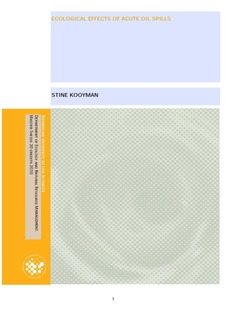Ecolocical effects of acute oil spills
Master thesis
Permanent lenke
http://hdl.handle.net/11250/186718Utgivelsesdato
2011-04-28Metadata
Vis full innførselSamlinger
- Master's theses (INA) [593]
Sammendrag
The coastal ecosystems are under constant pressure from natural and anthropogenic sources. The interactions between organisms and their environment is a complex myriad of changes and responses making impacts from acute pollution events both evident and subtle. Some ecosystems may be more resilient than others, and are able to withstand pressure to a great extent. Other, vulnerable systems may be very fragile and susceptible to impacts from outside events. Oil pollution is a threat to the ecosystems, resilient or not, as the effect an oil spill has on the environment cannot be predicted. The complexity of a spill situation are dependent on spill size, oil type, waves, weather, temperature and many other factors that not only affect the spill but also the ecosystems and organisms at risk. The acute effects from a spill are more easily detectable than long term sublethal effects. Persistence of oil in the environment may be a source of long term exposure to the organisms affecting growth, reproduction, oxidative stress, and in turn mortality. Some biological markers (biomarkers) have been developed to measure exposure to Polycyclic Aromatic Hydrocarbons (PAH), an oil component, in the organism. Biomarkers of Cytochrome P450, bile metabolites and DNA adducts have been detected in organisms after oil exposure. However, there is never only one pollutant present in the environment and attributing one effect to one pollutant may be very difficult. The pollutant may in turn affect each other in various ways. An oil spill is typically causing multiple stressor effects. This makes the need for accurate methods for attributing effects to pollutants great. The aim of the thesis was to evaluate the ecological effects seen after oil spills and which factors affected the outcome. The long Norwegian coastline has a high risk of oil spills from ships, and it is important to understand the spill situations to understand the impact it could have on ecosystems in Norway.
